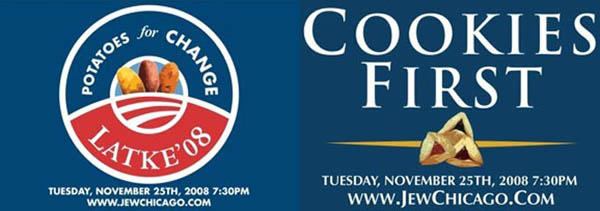Eternal Debate Rages On: Latke v. Hamantash
Permanent link All Posts

Potatoes for Change or Cookies First? Find out who will take the prize tonight at the University of Chicago
Hamantash fans scoff at the latke: “It’s just potatoes,” they say. And latke aficionados can’t find much to be excited about in the hamantash.
The debate about the favorite Jewish holiday food has raged for so long that it spawned an institutional response: the annual Latke-Hamantash Debate at the University of Chicago. The 62-year-old tradition has spread to campuses nationwide for a humorous academic discussion about the relative merits of the two iconic Jewish foods.
University of Chicago professors Gary Tubb (South Asian languages and civilizations), Thomas Ginsburg (law), Roy Weiss (medicine) and Dean of the Rockefeller Chapel Elizabeth Davenport will duke it out in this year’s verbal food fight tonight at 7:30 p.m. at Mandel Hall (1131 E. 57th St.) on the University of Chicago campus. Ted Cohen, professor of Near Eastern languages and civilizations, will moderate. The latke has won more times than the hamantash, although in recent times the pendulum has swung back and forth—the latke side won last year’s debate, while the hamantash got the vote in 2006.
As the debate continues between cooks everywhere, Oy!Chicago asked the community to chime in with their opinions. And at least in this completely unscientific sample, the latke took the lead.
Sarah Levy, owner of Sarah’s Pastries and Candies: “I have always loved latkes, which are a family favorite. It’s sort of a habit. My grandmother has a really good recipe.”
Rabbi Michael Balinsky, executive vice president of JUF’s Chicago Board of Rabbis: “I prefer the latke. I make terrific latkes and I don’t know how to make hamantash—I have never tried, I’m not into baking. I do not fry my latkes, instead, I bake them in the oven. The secret to great potato latkes is to grate in some carrot, and I also make great sweet potato latkes. I don’t work with recipes, I don’t measure. I just put things together, and it’s never the same twice.”
Josie A.G. Shapiro, chief development officer at Temple Sholom and an avid cook: “I’m a latke girl! They’re more flexible, you can grate different things in—potatoes, beets, or zucchini,The hamantashen have different fillings, but they’re all on the same note, all sweet.”
Miriam Brosseau, singer-songwriter and community mensch extraordinaire: “Coming from Wisconsin, where all food is fried, I’m kind of partial to the latke. Now, if it were served on a stick, that’s something Wisconsinites could really go for. Someday...”
Adam Davis, director of KFAR Jewish Arts Center: “It’s a difficult decision. On the one hand, I salivate at the thought of a savory potato and onion delicacy. I also am tantalized by the sweet triangular treat. I suggest a third way—the sufganiot. I’m a pluralist when it comes to the Jewish people and our food.”
Rabbi Rebecca Lillian, author, musician and spiritual leader: “How could I possibly compare latkes and hamantashen? Latkes are savory, and when fried to just the perfect crispy texture without burning, with a bit of sweet-tart applesauce on top, they are perfect on a cold winter night. I couldn’t imagine Chanukah without latkes. Hamantashen are sweet, although when filled with the right mohn (poppyseed) filling, not too sweet. They are perfect for a Purim meal when, together with more sweets and a bit of fermented beverage, one gets silly and giddy and goes a bit crazy with laughter. I couldn’t imagine Purim without hamantashen. But if you are really forcing me to choose, I'd pick the holiday of Purim—with latkes!”
Daniel Libenson, the director of the Newberger Hillel Center at the University of Chicago, has pledged to keep neutral on the issue. Libenson and the Newberger Hillel have betrayed a fondness for politics in the advertisements for the debate. In the ads, Obama’s signature “O” logo is repurposed for the latke, and “this is Obama’s year,” Libenson said.
Post-debate, hungry audience members can devour the contestants – three kinds of hamantash and two kinds of latke for $5.



.jpg)



